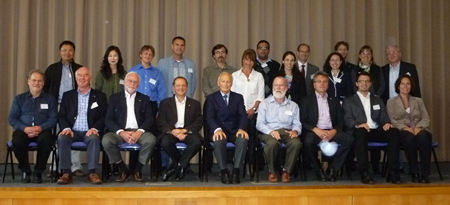
By Chris Kelsey – On September 26, immediately following the 10th International Conference on Geosynthetics (10 ICG), a high-level, one-day workshop on HDPE geomembranes convened at the headquarters of BAM, Germany’s Federal Institute for Materials Research and Testing. The event brought together field luminaries who represented not only the international practice but multiple perspectives from geosynthetics: polymer and additive package development, manufacturing, testing, design, and CQA.
The gathering, known as Berlin 2, is the successor of a similar workshop held at BAM in the mid-1990s. Here, roughly 18 years later, some of the same participants were able to be on hand to discuss the creation of a protocol for better anticipating the end of service life of an installed, exposed high-density polyethylene geomembrane.
Dr. Ian D. Peggs (I-CORP INTERNATIONAL) and Helmut Zanzinger (SKZ) served as moderators. Werner Müller (BAM) hosted. Dr. JP Giroud oversaw the discussion and helped steer the group towards its actions.
Additional participants and presenters include John Cowland (independent consultant), Mike Sadlier (independent consultant), Fred Gassner (Golder), Sebastian Hausmann (SKZ), Daniel Tan (Solmax), Hyun Jin Koo (Fiti), Chris Kelsey (Geosynthetica), Robert Kienzl (OFI), Mauricio Ossa (GSE), Catrin Tarnowski (GSE), Amr Ewais (Queen’s University, Canada), Ana Noval (CEDEX), Markus Grob (BASF), Montse Garcia (Dow), José Miguel Muñoz (Sotrafa), and Vera Olischläger (NAUE).
Contributing but unable to attend due to late developments were Han-Yong Jeon (INHA University) and John Scheirs (ExcelPlas).
DEVELOPING A PROTOCOL FOR HDPE GEOMEMBRANES
The results of the workshop will not be released immediately. An official report, with a recommended protocol, is expected, though its composition and approval will require some time for members of the Berlin 2 gathering to communicate via email, review notes, refine ideas, and, eventually, sign off on a recommendation.
What can be noted at this stage is that everyone had a lot to contribute. A sequence of 17 short presentations made it clear that the workshop was needed. The debate on when a geomembrane has reached the end of its service life is anything but clear. Identical materials, for example, will perform very differently, depending on climate, application, and design, installation, and operational expertise. A geomembrane in an aquaculture pond in Thailand will not age like that same geomembrane in a similar aquaculture operation in the northern United States. A geomembrane exposed to extremely hot pregnant liquor solution (PLS) at a mining and processing facility in Australia will–more than likely–have a far shorter service life than a similar HDPE geomembrane installed for potable water containment in Iran.
These may seem like obvious scenarios, but how can the end of service life be anticipated? The answer to this question may offer a tremendous impact for design and planning. (Already, the lack of a protocol, of a way to anticipate end of life, is a weight upon design and planning.) A protocol that can help determine the end of service life of a geomembrane could save many sites. It could allow owners to better anticipate changes, plan refurbishment into operations, and all and all avoid costly and disruptive sudden shut downs.
Some of the questions raised:
- Are we to apply a specific set of tests to samples taken at a specific frequency–in this case, from an exposed HDPE liner–and identify particular characteristics that indicate a particular percentage of loss from a stabilizer package?
- Is there a specific morphological change we are seeking as an indicator?
- How would sampling frequencies be altered to accommodate differently challenged sites?
- How do we respond to a geomembrane that, under a microscope or through a range of intensely detailed tests, has been shown to have lost its strength or stabilizers yet continues to perform its containment function as designed?
- How do we respond to a geomembrane that suffers some sort of failure–e.g., a degree of leakage that is not managed in the design–yet would, if tested, reveal itself still to be intact?
Those questions are just the tip of the iceberg, but the momentum from the workshop would suggest an initial protocol may be possible sooner rather than later. The guidance it can provide may then be utilized in evaluation of other geomembrane types.
Updates from the group will be published here in the coming months.
**
Chris Kelsey is the editor of Geosynthetica and served as a session secretary for Berlin 2. Elizabeth Peggs and Becky Slaybaugh (Minerva TRI, Geosynthetica’s publisher) provided organizational support to the event.











